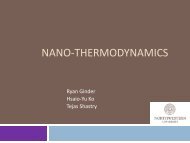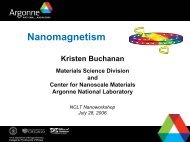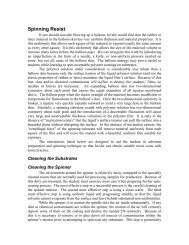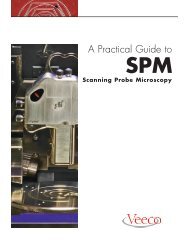Nanoscale Optical Properties ( ) ( )
Nanoscale Optical Properties ( ) ( )
Nanoscale Optical Properties ( ) ( )
You also want an ePaper? Increase the reach of your titles
YUMPU automatically turns print PDFs into web optimized ePapers that Google loves.
<strong>Nanoscale</strong> <strong>Optical</strong> <strong>Properties</strong><br />
When we studied chemical synthesis of nanoparticles, we briefly<br />
discussed nanoscale optical properties:<br />
(1) Semiconductor nanoparticles: Quantum confinement led to<br />
an increase in the energy of optical absorption and emission.<br />
(2) Semiconductor nanowires: Anisotropic structure led to<br />
polarization dependence of optical properties.<br />
P. Mulvaney, et al., MRS Bulletin, 26, 1009 (2001).<br />
Department of Materials Science and Engineering, Northwestern University<br />
(3) Metal nanoparticles: Absorption and scattering of light was<br />
size dependent, leading to color changes in colloidal<br />
solutions.<br />
Department of Materials Science and Engineering, Northwestern University<br />
Localized Surface Plasmon Resonance (LSPR):<br />
collective excitation of the conduction electrons<br />
Nuclear framework<br />
of particle<br />
E-field<br />
Metal<br />
sphere<br />
Size-Dependent Extinction Spectra<br />
Mie theory (1908):<br />
2 3 3/2<br />
24π Na ε ⎡<br />
m<br />
ε ⎤<br />
i<br />
E ( λ ) =<br />
⎢<br />
2<br />
⎥<br />
2<br />
λ ln(10) ⎢⎣( ε<br />
r+ χε<br />
m)<br />
+ ε<br />
i ⎥⎦<br />
Charge cloud of<br />
conduction electrons<br />
e - cloud<br />
Plasmon excitation influences the absorption and<br />
scattering of light from the surfaces of metals.<br />
ε m<br />
ε r , ε i<br />
a<br />
E(λ) = Extinction spectrum = absorption + scattering<br />
χ = shape factor (2 for sphere, > 2 for spheroid)<br />
ε m = external dielectric constant<br />
ε r = real metal dielectric constant<br />
ε i = imaginary metal dielectric constant<br />
Courtesy of Professor Richard Van Duyne<br />
Department of Materials Science and Engineering, Northwestern University<br />
Courtesy of Professor Richard Van Duyne<br />
Department of Materials Science and Engineering, Northwestern University<br />
Size-Tunable Surface Plasmon Resonances<br />
Size-Tunable Surface Plasmon Resonances<br />
Normalized Extinction<br />
120 150 150 95 120 145 145 145 width<br />
42 70 62 48 46 59 55 50 height<br />
shape<br />
426 446 497 565 638 720 747 782 λ<br />
max<br />
Ag/mica<br />
400 500 600 700 800 900<br />
Wavelength (nm)<br />
T. R. Jensen, et al., J. Phys. Chem. B, 104, 10549 (2000).<br />
Department of Materials Science and Engineering, Northwestern University<br />
Calculated Electric Field:<br />
20 nm diameter Ag Sphere in vacuum<br />
Polarization<br />
Propagation<br />
Shape Dependence<br />
Department of Materials Science and Engineering, Northwestern University<br />
48<br />
42<br />
36<br />
30<br />
24<br />
18<br />
12<br />
6<br />
0<br />
Calculated Electric Field:<br />
100 nm Ag Triangle in vacuum<br />
Courtesy of Professor George Schatz<br />
1
Nanosphere Lithography<br />
Nanosphere Lithography Size and Spacing Control<br />
J. C. Hulteen, et al., J. Vac. Sci. Technol. A, 13, 1553 (1995).<br />
Department of Materials Science and Engineering, Northwestern University<br />
ip<br />
d ip<br />
d = 1/<br />
( )<br />
D<br />
3 D = 0.577 D<br />
D = 542 nm<br />
a = 126 nm ; d ip = 313 nm<br />
Examples:<br />
3⎛<br />
1 ⎞<br />
a = 3-1- D<br />
2<br />
⎜ ⎟<br />
⎝ 3 ⎠<br />
= 0.233D<br />
D = 400 nm<br />
a = 93 nm ; d ip = 231 nm<br />
Department of Materials Science and Engineering, Northwestern University<br />
a<br />
Nanosphere Lithography: Single Layer Mask<br />
Surface Confined AFM<br />
Released TEM<br />
95<br />
nm<br />
D = 542 nm<br />
a = 126 nm ; d ip = 313 nm<br />
D = 400 nm<br />
a = 93 nm ; d ip = 231 nm<br />
Department of Materials Science and Engineering, Northwestern University<br />
Department of Materials Science and Engineering, Northwestern University<br />
Size-Tunable Ag Nanoparticle Arrays<br />
SL<br />
DL<br />
D<br />
A<br />
A<br />
315 nm<br />
155 nm<br />
540 nm<br />
110 nm<br />
18 nm<br />
18 nm<br />
B<br />
B<br />
231 nm<br />
121 nm<br />
399 nm<br />
97 nm<br />
18 nm<br />
18 nm<br />
542 nm 401 nm 266 nm 165 nm<br />
Department of Materials Science and Engineering, Northwestern University<br />
C<br />
C<br />
153 nm<br />
78 nm<br />
267 nm<br />
64 nm<br />
18 nm<br />
18 nm<br />
D<br />
D<br />
93 nm<br />
42 nm<br />
163 nm<br />
30 nm<br />
10 nm<br />
J. C. Hulteen, D. A. Treichel, M. T. Smith, M. L. Duval, T. R. Jensen,<br />
R. P. Van Duyne, J. Phys. Chem. B, 3854-3863 (1999).<br />
6 nm<br />
Advantages of Nanosphere Lithography<br />
• Massively Parallel: 10 10 nanostructures cm -2<br />
• Simple, inexpensive: < $1 / sample<br />
• High throughput: ~ 10 samples/day/person<br />
• Materials and substrate general<br />
• Minimum feature size is ~ 20 nm<br />
• 1 nm control of nanogaps<br />
• Precision control of nanoparticle size<br />
Department of Materials Science and Engineering, Northwestern University<br />
2
-1<br />
-1<br />
Disadvantages of Nanosphere Lithography<br />
No Arbitrary Patterns<br />
No independent control<br />
of in-plane size and spacing<br />
0.1 – 1% Defects from<br />
Nanosphere Polydispersity<br />
Line Defects<br />
Point Defects<br />
Polycrystalline<br />
Domains<br />
Department of Materials Science and Engineering, Northwestern University<br />
Localized Surface Plasmon Resonance<br />
Spectroscopy of Ag Nanoparticle Array<br />
Extinction<br />
λ max = 586 nm<br />
0.35 ev<br />
400 600<br />
Wavelength (nm)<br />
uv-vis Extinction<br />
PPA<br />
I 0<br />
I<br />
AFM image<br />
2.3 µ m<br />
a = 117 nm<br />
d<br />
ip<br />
= 230 nm<br />
b = 59 nm<br />
d<br />
tt<br />
= 91 nm<br />
Department of Materials Science and Engineering, Northwestern University<br />
800<br />
Jensen, T. R.; Schatz, G. C.; Van Duyne, R. P. J. Phys. Chem. B 1999, 2394-2401.<br />
Near and Mid-Infrared LSPR Spectra<br />
Extinction<br />
Extinction<br />
Wavelength (nm)<br />
600 800 1000 2000<br />
λ max=8888.8 cm -1<br />
max = 8889 cm -1 λ -1<br />
max = 2110 cm -1<br />
0.04 au<br />
16,000 12,000 8,000<br />
-1<br />
Wavenumber (cm )<br />
Wavelength (nm)<br />
600 800 1000 2000<br />
λλ max=7331 -1<br />
max = 7331 cm -1<br />
0.023 au<br />
16,000 12,000 8,000<br />
-1<br />
Wavenumber (cm )<br />
397 nm<br />
559 nm<br />
243 nm<br />
28 nm<br />
323 nm<br />
23 nm<br />
T. R. Jensen, et al., J. Phys. Chem. B, 104, 10549 (2000).<br />
Department of Materials Science and Engineering, Northwestern University<br />
A<br />
B<br />
Extinction<br />
Extinction<br />
3000<br />
3000<br />
Wavelength (nm)<br />
4000 6000 10,000<br />
0.1 au<br />
2000<br />
Wavenumber (cm )<br />
Wavelength (nm)<br />
4000 6000 10,000<br />
0.1 au<br />
λλ max = cm -1<br />
max = 1655 cm -1<br />
2000<br />
Wavenumber (cm )<br />
1000<br />
1000<br />
1555 nm<br />
1390 nm<br />
65 nm<br />
897 nm<br />
830 nm<br />
50 nm<br />
C<br />
D<br />
Extinction Efficiency<br />
Theory vs. Experiment : Effect of Substrate<br />
28 nm height PPA<br />
12<br />
0.28<br />
8<br />
4<br />
DDA<br />
no substrate<br />
DDA<br />
with substrate<br />
Ag<br />
mica<br />
0<br />
0.12<br />
400 500 600 700 800 900<br />
Wavelength (nm)<br />
Department of Materials Science and Engineering, Northwestern University<br />
0.24<br />
0.20<br />
0.16<br />
Measured Extinction<br />
New Stuctural Motifs for Nanosphere Lithography<br />
Angle Resolved Nanosphere Lithography<br />
Department of Materials Science and Engineering, Northwestern University<br />
C. L. Haynes, R. P. Van Duyne, J. Phys. Chem. B, 105, 5599 (2001).<br />
Department of Materials Science and Engineering, Northwestern University<br />
3
E-field Intensity<br />
E-field Intensity<br />
Angle Resolved Nanosphere Lithography<br />
LSPR (nm) vs. Interparticle Spacing (d )<br />
λ max<br />
tt<br />
680<br />
Weak Interparticle Coupling<br />
1 nm spacing<br />
is achievable<br />
experimentally<br />
LSPR (nm)<br />
λ max<br />
640<br />
600<br />
LSPR<br />
λ λ max max = 574 nm<br />
Theory:<br />
DDA<br />
Independent Nanoparticles<br />
AFM<br />
d<br />
tt<br />
= 114 nm<br />
C. L. Haynes, R. P. Van Duyne, J. Phys. Chem. B, 105, 5599 (2001).<br />
Department of Materials Science and Engineering, Northwestern University<br />
560<br />
0 40 80 120<br />
Interparticle Spacing, d tt (nm)<br />
T. R. Jensen, G. C. Schatz, R. P. Van Duyne, J. Phys. Chem. B, 103, 2394-2401 (1999).<br />
Department of Materials Science and Engineering, Northwestern University<br />
Electric Field Enhancement<br />
E<br />
k<br />
852 nm<br />
E<br />
k<br />
57,000<br />
653 nm<br />
2700<br />
Department of Materials Science and Engineering, Northwestern University<br />
4
















